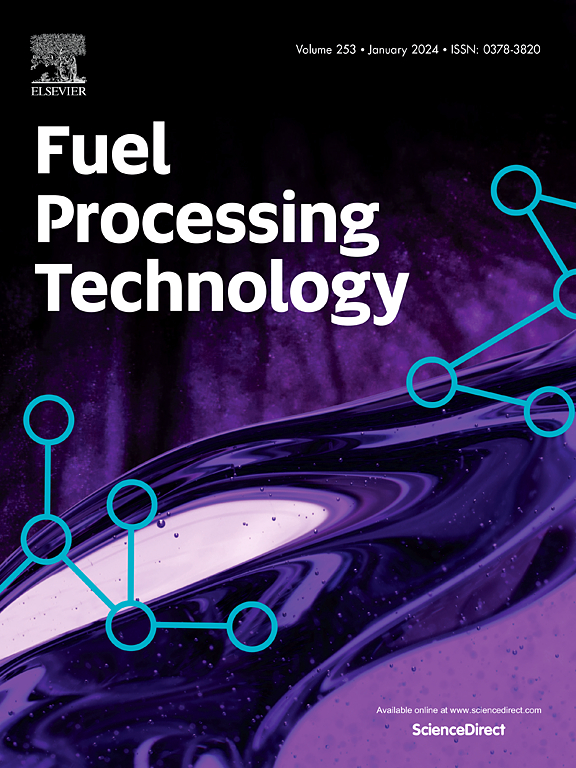Experimental evaluation of the influence of blends of aviation fuel with RME on the performance of an engine with a common-rail power system
IF 7.7
2区 工程技术
Q1 CHEMISTRY, APPLIED
引用次数: 0
Abstract
This paper presents original experimental research aimed at determining the effect of blends of aviation fuel with plant-based fuels on the useful parameters and exhaust gas composition of a compression-ignition engine with a common-rail (CR) tray power system. Original results were obtained for the parameters of an engine fueled with six fuels differing in chemical composition: the base fuel (F-54 diesel), F-34 aviation fuel, and four blends formed from F-34 fuel and RME (Rape Methyl Ester - rapeseed oil fatty acid methyl esters) with different weight percentages in the blend. Studies of blends of jet fuel with biocomponents in a wide range of shares in military fuel applications are not found in the available literature. The performance of the tested engine changed significantly. A decrease in useful power of about 3 % was obtained when the engine was powered by aviation fuel, compared to an engine powered by diesel fuel. For mixtures of aviation fuel F-34 with RME, the decrease is 5–10 %, depending on the content of RME in the mixture. Specific fuel consumption is higher for blends with methyl esters, and the increase is proportional to the RME content in the blend, ranging from 6 to 12 % depending on the proportion of RME, resulting in increased fuel demand. Supplying the engine with mixtures of F-34 fuel with RME resulted in an increase in average CO2, CO and HC emissions in the range of 12–18 %. The addition of RME to F-34 fuel resulted in an almost 3-fold reduction in smoke opacity compared to powering an F-54 engine, a phenomenon that is very beneficial from an environmental perspective. It is possible to use mixtures of F-34 jet fuel with RME to power modern internal combustion engines with common-rail power systems, which expand the fuel range during armed conflicts.

航空燃油与RME混合对共轨动力系统发动机性能影响的实验研究
本文介绍了一种新颖的实验研究,旨在确定航空燃料与植物燃料混合对共轨(CR)托盘动力系统压燃发动机有用参数和废气成分的影响。用六种不同化学成分的燃料(基础燃料(F-54柴油),F-34航空燃料,以及由F-34燃料和RME(菜籽油甲酯-菜籽油脂肪酸甲酯)组成的四种混合物,在混合物中加入不同重量百分比的混合物,得到了发动机参数的原始结果。在现有文献中没有发现在军事燃料应用中广泛份额的喷气燃料与生物组分的混合物的研究。测试发动机的性能发生了显著变化。当发动机以航空燃料为动力时,与以柴油为动力的发动机相比,有效功率下降了约3%。对于航空燃料F-34与RME的混合物,减少5 - 10%,取决于混合物中RME的含量。含有甲酯的混合物比燃料消耗更高,其增加与混合物中RME的含量成正比,根据RME的比例,从6%到12%不等,导致燃料需求增加。为发动机提供含有RME的F-34燃料混合物导致二氧化碳、一氧化碳和HC的平均排放量增加了12 - 18%。与为F-54发动机提供动力相比,在F-34燃料中添加RME导致烟雾不透明度降低了近3倍,这一现象从环境的角度来看非常有益。有可能使用F-34喷气燃料和RME的混合物为带有共轨动力系统的现代内燃机提供动力,这在武装冲突期间扩大了燃料范围。
本文章由计算机程序翻译,如有差异,请以英文原文为准。
求助全文
约1分钟内获得全文
求助全文
来源期刊

Fuel Processing Technology
工程技术-工程:化工
CiteScore
13.20
自引率
9.30%
发文量
398
审稿时长
26 days
期刊介绍:
Fuel Processing Technology (FPT) deals with the scientific and technological aspects of converting fossil and renewable resources to clean fuels, value-added chemicals, fuel-related advanced carbon materials and by-products. In addition to the traditional non-nuclear fossil fuels, biomass and wastes, papers on the integration of renewables such as solar and wind energy and energy storage into the fuel processing processes, as well as papers on the production and conversion of non-carbon-containing fuels such as hydrogen and ammonia, are also welcome. While chemical conversion is emphasized, papers on advanced physical conversion processes are also considered for publication in FPT. Papers on the fundamental aspects of fuel structure and properties will also be considered.
 求助内容:
求助内容: 应助结果提醒方式:
应助结果提醒方式:


